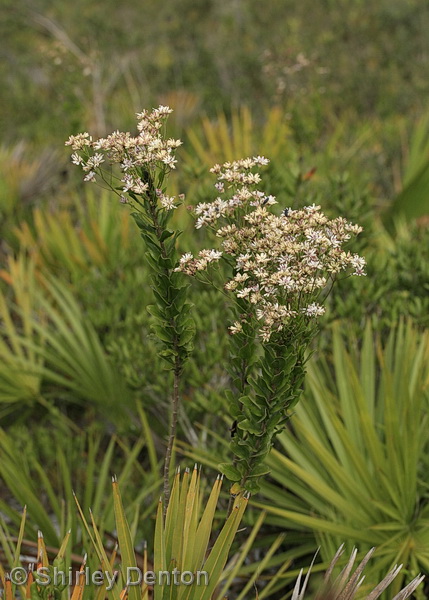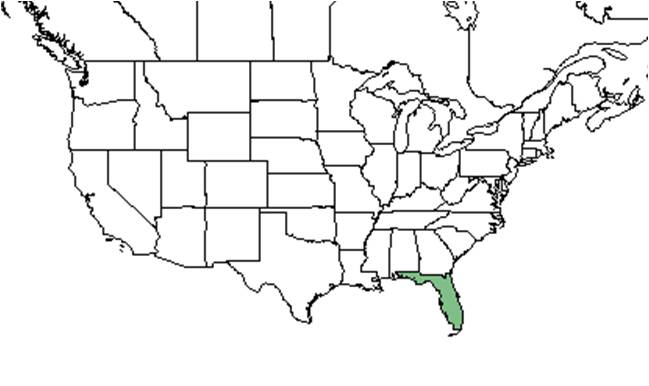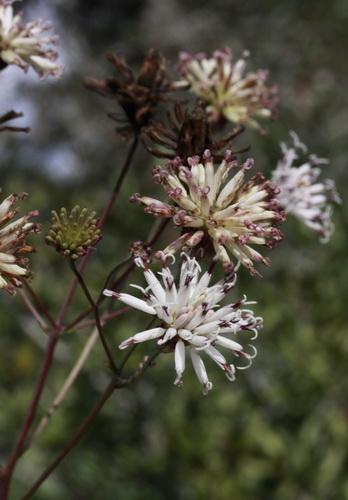Difference between revisions of "Palafoxia feayi"
HaleighJoM (talk | contribs) (→Ecology) |
|||
| (One intermediate revision by one other user not shown) | |||
| Line 53: | Line 53: | ||
===Pollination=== | ===Pollination=== | ||
| − | The following Hymenoptera | + | The following Hymenoptera species were observed visiting flowers of ''Palafoxia feayi'' at the Archbold Biological Station:<ref name="Deyrup 2015">Deyrup, M.A. and N.D. 2015. Database of observations of Hymenoptera visitations to flowers of plants on Archbold Biological Station, Florida, USA.</ref> |
| − | Apidae: | + | Bees from the family Apidae: ''Apis mellifera, Bombus impatiens'' |
| − | Colletidae: | + | Plasterer bees from the family Colletidae: ''Colletes thysanellae'' |
| − | Halictidae: | + | Sweat bees from the family Halictidae: ''Agapostemon splendens, Augochlorella aurata, Augochloropsis sumptuosa, Halictus poeyi, Lasioglossum pectoralis, L. placidensis'' |
| − | Megachilidae: | + | Leafcutting bees from the family Megachilidae: ''Anthidiellum perplexum, Coelioxys sayi, Megachile albitarsis, M. brevis pseudobrevis, M. georgica, M. inimica, M. mendica, M. petulans, M. policaris, M. texana, M. xylocopoides'' |
| − | Pompilidae: | + | Spider wasps from the family Pompilidae: ''Episyron conterminus posterus'' |
| − | Sphecidae: | + | Thread-waisted wasps from the family Sphecidae: ''Ammophila urnaria, Tachytes pepticus'' |
| − | Vespidae: | + | Wasps from the family Vespidae: ''Parancistrocerus perennis anacardivora, Zethus slossonae, Z. spinipes'' |
| − | <!--=== | + | <!--===Herbivory and toxicology===--> |
<!--===Diseases and parasites===--> | <!--===Diseases and parasites===--> | ||
Latest revision as of 20:15, 14 July 2022
| Palafoxia feayi | |
|---|---|

| |
| Photo by Shirley Denton (Copyrighted, use by photographer’s permission only) Nature Photography by Shirley Denton | |
| Scientific classification | |
| Kingdom: | Plantae |
| Division: | Magnoliophyta - Flowering plants |
| Class: | Magnoliopsida – Dicotyledons |
| Order: | Asterales |
| Family: | Asteraceae ⁄ Compositae |
| Genus: | Palafoxia |
| Species: | P. feayi |
| Binomial name | |
| Palafoxia feayi A. Gray | |

| |
| Natural range of Palafoxia feayi from USDA NRCS Plants Database. | |
Common name: Feay's palafox[1]
Contents
Taxonomic notes
Synonyms: none.[1]
Varieties: none.[1]
The genus Palafoxia is named after Jose de Palafox y Melci a Spanish captain-general, well known in the Peninsular War. The species is named for William T. Feay, who was an avid plant collector in the southeast.[2]
Description
A description of Palafoxia feayi is provided in The Flora of North America.
It's a perennial suffrutescent herb or shrub, growing to 3-15 dm tall. The inflorescence heads have 10-30 florets. The phyllaries are 5-9 mm long and of equal length. The pappus scales of the inner cypselas are 1.5-2 mm long. Four times as long as wide, the leaves are entire, opposite, and elliptic to ovate.[1]
Distribution
P. feayi is endemic to Florida, ranging from the peninsula to Dixie, Marion, and Volusia counties.[1]
Ecology
Habitat
P. feayi is restricted to the well-drained sandy uplands of the southern two-thirds of the Florida peninsula.[2] Habitats include oak-palmetto-Lyonia scrubs, sand pine scrubs, and pine/palmetto scrubs. It has also been observed growing with Bigelowia nuttallii in sandbur-natal grass in an open sand pine remnant. Associated species include Bigelowia nuttallii, Serenoa repens, Pinus clausa, natalgrass, sandbur, and oak species.[3]
Phenology
This species flowers from July through December.[3]
Seed bank and germination
Recently burned and unburned sites in Highlands and Polk Counties in south-central Florida, P. feayi was found in above-ground vegetation and the seed bank.[4][5]
Fire ecology
It has been observed growing in a burned scrub.[3]
Fire is important for maintaining the scrub habitat and occurs in intervals ranging from 10-100 years, depending on the specific scrub. Above ground P. feayi individuals are killed by fire, however, it quickly resprouts after fire. This species has adapted to fire by establishing seedlings between fires and resprouting postfire from the root system. Reproduction peaks during the first year post-fire and sharply declines after the first year [6]. There is a strong decrease in AMF colonization with time since fire, however, it is proposed that this is the result of an ephemeral nutrient pulse associated with scrub fires and changes in light availability.[7] On the contrary to these findings, there is not a change in mycorrhizal colonization associated with fire.[6]
Pollination
The following Hymenoptera species were observed visiting flowers of Palafoxia feayi at the Archbold Biological Station:[8]
Bees from the family Apidae: Apis mellifera, Bombus impatiens
Plasterer bees from the family Colletidae: Colletes thysanellae
Sweat bees from the family Halictidae: Agapostemon splendens, Augochlorella aurata, Augochloropsis sumptuosa, Halictus poeyi, Lasioglossum pectoralis, L. placidensis
Leafcutting bees from the family Megachilidae: Anthidiellum perplexum, Coelioxys sayi, Megachile albitarsis, M. brevis pseudobrevis, M. georgica, M. inimica, M. mendica, M. petulans, M. policaris, M. texana, M. xylocopoides
Spider wasps from the family Pompilidae: Episyron conterminus posterus
Thread-waisted wasps from the family Sphecidae: Ammophila urnaria, Tachytes pepticus
Wasps from the family Vespidae: Parancistrocerus perennis anacardivora, Zethus slossonae, Z. spinipes
Conservation, cultivation, and restoration
P. feayi is endemic to the scrubs of the Florida peninsula[2] and is found in habitats along the Lake Wales Ridge. This ridge is quickly converted into urban and agricultural areas. These disturbances have fragmented the scrub into a patchwork of small scrubs interspersed among urbanized patches.[9] Fire suppression also threatens the scrub habitats by allowing for the encroachment of hardwoods.
Cultural use
Photo Gallery
Flowers of Palafoxia feayi Photo by Shirley Denton (Copyrighted, use by photographer’s permission only) Nature Photography by Shirley Denton
References and notes
Carrington, M. E. (1999). "Post-Fire Seedling Establishment in Florida Sand Pine Scrub." Journal of Vegetation Science 10(3): 403-412.
Conrad, A. O. and K. A. Segraves (2012). "Mycorrhizal colonization of Palafoxia feayi (Asteraceae) in a pyrogenic ecosystem." Mycorrhiza 23(3): 243-249.
Olano, J. M., E. S. Menges, et al. (2006). "Carbohydrate Storage in Five Resprouting Florida Scrub Plants across a Fire Chronosequence." The New Phytologist 170(1): 99-105.
- ↑ 1.0 1.1 1.2 1.3 1.4 Weakley, A.S. 2015. Flora of the southern and mid-atlantic states. Working Draft of 21 May 2015. University of North Carolina at Chapel Hill, Chapel Hill, North Carolina.
- ↑ 2.0 2.1 2.2 [[1]] Native Florida Wildflowers. Accessed: February 16, 2016
- ↑ 3.0 3.1 3.2 Florida State University Robert K. Godfrey Herbarium database. URL: http://herbarium.bio.fsu.edu. Last accessed: October 2015. Collectors: Loran C. Anderson, D. Burch, George R. Cooley, R.J. Eaton, Robert K. Godfrey, R. Kral, Olga Lakela, S.W. Leonard, Victoria Sullivan, D.B. Ward. States and Counties: Florida: Brevard, Collier, Highlands, Indian River, Lake, Manatee, Marion, Pinellas, Polk. Compiled by Tall Timbers Research Station and Land Conservancy.
- ↑ Carrington, M. E. 1997. Soil Seed Bank Structure and Composition in Florida Sand Pine Scrub. American Midland Naturalist 137(1):39-47.
- ↑ Lang, N. L. 2011. Soil seed bank dynamics of southern Lake Wales Ridge sandhill communities. Archbold Biological Station, Venus, Florida,15 pg.
- ↑ 6.0 6.1 Ostertag R, Menges ES. 1994. Patterns of reproductive effort with time since last fire in Florida scrub plants. Journal of Vegetation Science. 5(3): https://doi.org/10.2307/3235853.
- ↑ Conrad AO, Segraves KA. 2013. Mycorrhizal colonization of Palafoxia feayi (Asteraceae) in a pyrogenic ecosystem. Mycorrhiza. 23(3):243-9. doi: 10.1007/s00572-012-0469-4.
- ↑ Deyrup, M.A. and N.D. 2015. Database of observations of Hymenoptera visitations to flowers of plants on Archbold Biological Station, Florida, USA.
- ↑ Sumoski, S. E., A. J. Johncox, et al. (2009). "Impact of Urbanization on Tri-Trophic Interactions in an Endemic Scrub Community." The Florida Entomologist 92(4): 582-587.
